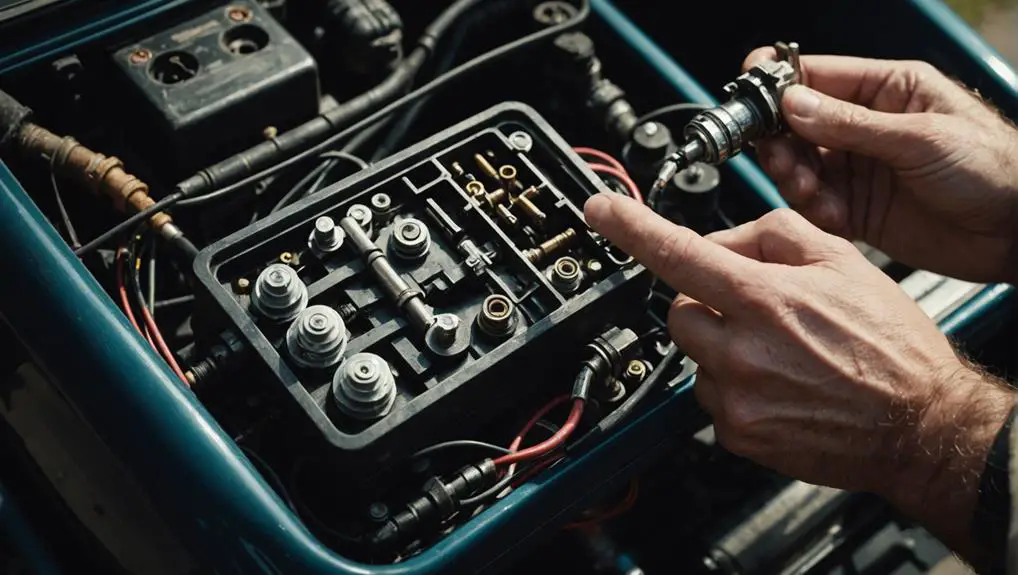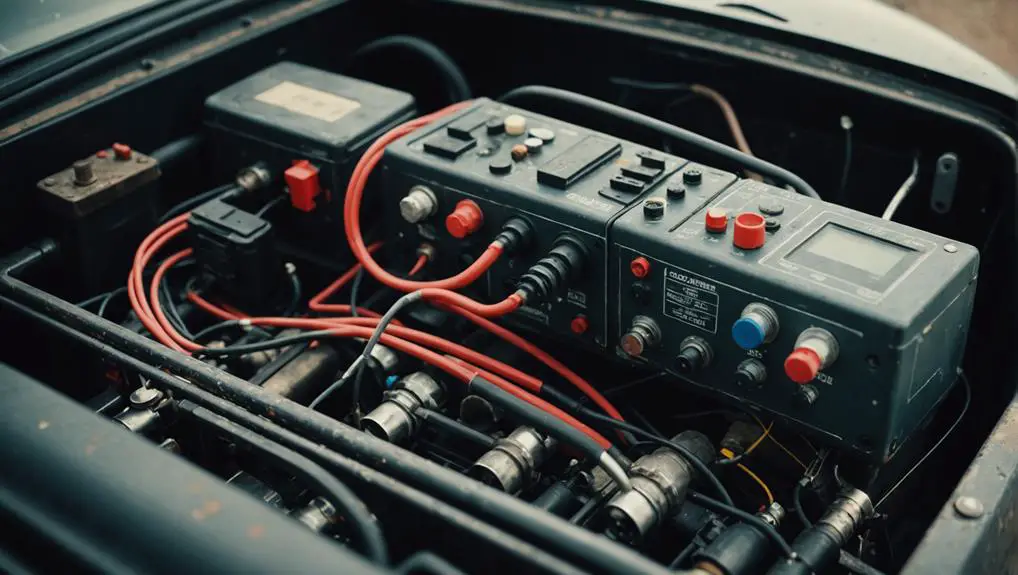Imagine the sun glinting off your gas golf cart as you turn the key, only to hear the engine sputter and fade into silence. It's frustrating when your cart turns over but won't start, leaving you stranded in the driveway. You'll want to tackle this issue methodically, starting with a few key systems that could be the culprit. From the fuel lines to the battery, each component plays a role in getting your cart back on track. So, where do you begin this troubleshooting journey?
Key Takeaways
- Check the fuel level and ensure fresh gasoline is present; low fuel can prevent starting.
- Inspect fuel lines for cracks or leaks, and replace any damaged sections to prevent fuel loss.
- Examine the battery condition; ensure terminals are clean and voltage is above 12.4 volts for optimal performance.
- Test the ignition system, focusing on the spark plug and ignition coil for wear or faults that may hinder starting.
- Evaluate electrical connections, ensuring all wires and terminals are secure and free from corrosion to maintain proper function.
Check the Fuel System
The fuel system is essential for your gas golf cart's performance. To guarantee it operates correctly, start by checking the fuel level in the tank. If it's low, fill it with fresh gasoline, as old fuel can cause starting issues.
Next, inspect the fuel lines for any cracks or leaks. Damaged lines can lead to fuel loss and inadequate supply to the engine.
After that, examine the fuel filter. A clogged filter restricts fuel flow, preventing the engine from starting. If it looks dirty or hasn't been replaced recently, swap it out for a new one.
Following this, check the carburetor. Look for any signs of dirt or debris that can hinder fuel delivery. If you notice any buildup, clean it thoroughly with a carburetor cleaner.
Lastly, confirm the operation of the fuel pump. Listen for a humming sound when you turn the ignition on. If you don't hear it, the pump might be faulty and require replacement.
Inspect the Battery Condition
Before troubleshooting other issues, it's crucial to inspect the battery condition, as it plays an important role in starting your gas golf cart.
Start by checking the battery terminals for corrosion or loose connections. If you notice any buildup, clean it using a mixture of baking soda and water. Make sure to disconnect the battery cables before cleaning to avoid any electrical shorts.
Next, use a multimeter to test the battery voltage. A healthy battery should read around 12.6 volts or higher when fully charged. If the reading is below 12.4 volts, it's likely time to recharge or replace the battery.
Also, inspect the battery itself for any signs of swelling, leaks, or cracks. If you find any physical damage, replace the battery immediately.
Examine the Ignition System

After confirming the battery is in good condition, focus on examining the ignition system. A malfunctioning ignition system can prevent your gas golf cart from starting, even if the battery and other components are fine.
Here's how to effectively troubleshoot the ignition system:
- Inspect the Ignition Switch: Turn the key and verify it's functioning properly. If you notice any unusual resistance or it feels loose, it might need replacement.
- Check the Spark Plug: Remove the spark plug and inspect it for wear or carbon buildup. A damaged or dirty spark plug can hinder ignition.
- Examine the Ignition Coil: Use a multimeter to test the ignition coil's resistance. A faulty coil could result in no spark reaching the engine.
- Inspect the Wiring: Look for any frayed or disconnected wires leading to the ignition system. Confirming solid connections and intact wiring is vital for proper function.
After you've completed these checks, you'll have a clearer idea of whether the ignition system is the source of your starting issues.
If everything checks out, you may need to explore other components.
Test the Starter and Solenoid
When troubleshooting a gas golf cart that won't start, testing the starter and solenoid is essential. Start by ensuring the battery is fully charged and the connections are clean.
Next, locate the solenoid, usually mounted on the frame near the battery. Check for signs of damage or corrosion on the solenoid terminals.
To test the solenoid, use a multimeter set to the DC voltage range. With the ignition on, activate the starter switch and check for voltage at the solenoid. If you don't see any voltage, the ignition switch or wiring could be faulty. If there's voltage, it indicates the solenoid is likely functioning.
Next, test the starter itself. Disconnect the starter from the cart and use jumper cables to connect it directly to the battery. If the starter engages and spins, it's operational. If it doesn't turn over, the starter may need replacement.
Always remember to reconnect everything securely before testing again. By focusing on the starter and solenoid, you can effectively narrow down the root of your golf cart's starting issues.
Evaluate Electrical Connections

To guarantee your gas golf cart functions properly, evaluate all electrical connections carefully. Faulty connections can prevent your cart from starting, even if the starter and solenoid are working.
Follow these steps to verify everything's in order:
- Inspect Battery Terminals: Check for corrosion or loose connections at the battery terminals. Clean and tighten them as needed.
- Examine Wires and Cables: Look for any frayed or damaged wires and cables. Replace any that show signs of wear or damage.
- Check the Key Switch: Verify the key switch is functioning properly. Test the switch with a multimeter to confirm continuity when it's in the "on" position.
- Inspect Fuses and Relays: Examine the fuses and relays in the electrical system. Replace any blown fuses, and test relays to verify they're operational.
Frequently Asked Questions
How Can I Tell if My Gas Golf Cart Needs Oil Changes?
To determine if your gas golf cart needs an oil change, check the oil level and color.
If the oil's low or looks dark and gritty, it's time for a change.
You should also follow the manufacturer's recommended maintenance schedule, typically every 100 hours of operation or annually.
Pay attention to any unusual engine noises or performance issues, as these can signal that the oil is dirty or insufficient.
What Are Common Signs of a Clogged Fuel Filter?
Common signs of a clogged fuel filter include engine stalling, reduced power, and difficulty starting.
You might notice your golf cart hesitating during acceleration or sputtering when you push the gas pedal.
Additionally, if the engine runs rough or there's a noticeable drop in fuel efficiency, it's likely time to check the fuel filter.
Regular maintenance can prevent these issues, so keep an eye on your cart's performance and address any changes promptly.
Can I Use Any Battery for My Golf Cart?
You can't just grab any battery for your golf cart; using the wrong battery can lead to frustration and damage.
Golf carts typically require specific deep-cycle batteries designed for repeated discharge and recharge.
While it might be tempting to use a standard car battery, it won't provide the same longevity or performance.
Always check your cart's specifications to guarantee you choose the right battery for peak performance and reliability.
How Often Should I Replace Spark Plugs in My Golf Cart?
You should replace the spark plugs in your golf cart every 100 to 200 hours of operation or at least once a year, whichever comes first.
Regularly checking their condition can help maintain engine performance and fuel efficiency.
If you notice rough idling, misfires, or decreased power, it's a good idea to inspect and potentially replace them sooner.
Keeping your spark plugs in good condition guarantees a smoother ride and better reliability.
What Safety Precautions Should I Take While Troubleshooting?
When troubleshooting, always prioritize safety. Wear safety goggles and gloves to protect yourself from potential hazards.
Make certain the golf cart is on a flat surface and the engine is off before you begin. Disconnect the battery to prevent accidental starts, and keep tools organized to avoid tripping hazards.
Be cautious around moving parts and hot surfaces, and never work on a cart with flammable materials nearby.
These precautions can help guarantee a safe troubleshooting process.
Conclusion
In the world of gas golf carts, troubleshooting is like steering through a maze; each step reveals a new path to the solution. By systematically checking the fuel, battery, ignition, starter, and electrical connections, you'll open the door to reliable performance. Remember, every component plays a vital role, much like the gears in a well-oiled machine. With patience and attention to detail, you can breathe life back into your cart and hit the greens once more.